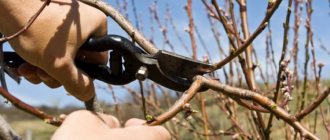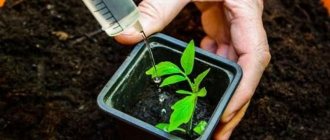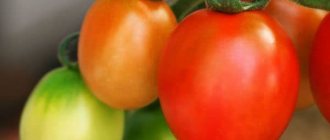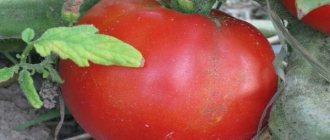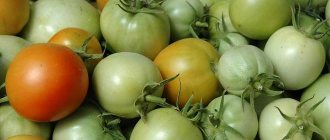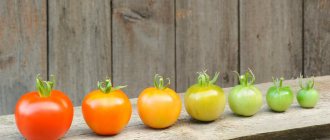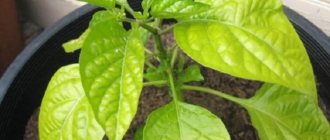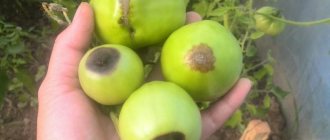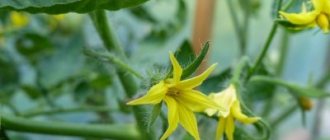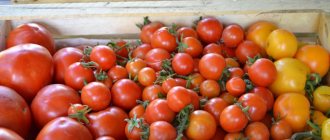Gardeners who have at least once grown indeterminate tomatoes know how important it is not only to properly water and feed the bushes, but also to prune them. Thanks to this manipulation, the yield of the plant increases, and the risk of developing fungal diseases is reduced significantly. In addition, shaped tomatoes take up less space in the garden bed, which is very important when cultivating Solanaceae in a shelter. How to prune tomatoes in the garden and in the greenhouse without causing damage to your favorite plants?
How to properly trim tomatoes at the roots?
- 1 How to properly trim tomatoes at the roots?
- 2 Trimming the top of a tomato bush
- 3 Which leaves to trim from tomatoes
- 4 How to trim low-growing tomatoes
- 5 How to trim stepsons correctly 5.1 Techniques for cutting stepsons
There are two stages to pruning the roots of a tomato bush.
The first stage begins while the seedlings are still in pots. This stage is usually called picking. The process is simple - the plant is removed from the soil, the root system is cleared of soil and trimmed by a third.
The second stage is carried out when planting tomatoes in open ground. During this period, it is very important to carry out pruning as carefully as possible so as not to damage the plant. Therefore, more than a third of the length is not cut off, otherwise there is a high risk of destroying the bush.
This is not the only option for pruning tomatoes. To obtain high productivity of a tomato bush and a good harvest, pinching, pinching and dividing into two parts is used.
The last method will be relevant for those who did not receive the planned volumes of seedlings and want to get the required quantity before planting in open ground.
Mass pruning time
At the stage of active ripening, when the first cool weather appears in the morning, tomatoes that grow in open soil are massively pruned. It is worth exposing the stems and trunks greatly, leaving seven intact leaves. The growth is fixed and the top is pinched.
At the same time, they fertilize the soil with potassium and phosphorus fertilizers. This adds speed to ripening and has a positive effect on the taste of the fruit. In a greenhouse, this process is carried out in the middle of the autumn season. Then condensation begins to collect on the walls. Ventilation is recommended.
It is worth paying attention to signs from the root system to decreased growth. The sign will be in the form of juice breaking through the top. After mass pruning, it is not necessary to reduce soil moisture, otherwise the fruits will begin to crack.
Trimming the top of a tomato bush
Moving on to other types of pruning tomato bushes, we cannot fail to mention pruning the tops. The process is quite simple and will not take much time. At the same time, it will provide the plant with enormous benefits - the yield will increase, and the shape of the crown will also change. This process is very important during the period of bush formation, when the problem of intensive growth forces gardeners to install garter stakes so that the plants do not break during the wind due to too much length. You don’t have to put in any special effort, because it’s enough to pinch off the top - everything that is above the second sheet.
What leaves to trim from tomatoes
In addition to pinching, which we will talk about later, there is the practice of picking leaves from tomato bushes. Experienced gardeners claim that this manipulation makes it possible to distribute all the plant’s forces between flowers and fruits, without wasting it on growing green mass. In addition, the lower leaves, when in contact with the ground, can become a transmitter of infections.
Leaf pruning occurs in mid to late June. 1-3 lower leaves are removed per week until the summer resident reaches the first inflorescence. Without leaves, the tomatoes will be ventilated more and the extra load will be removed from them. Each summer resident determines the number of leaves removed from the bush himself. But there is one rule that will give beginners the opportunity to navigate: until the ovary of all the fruits has completely set in the cluster, all the leaves should remain above the cluster. To ensure that the wound at the site where the leaf was cut heals quickly and that no harmful infection gets into it, the leaves are removed in the morning in sunny weather.
The benefits of pinching
Tomatoes are among the very branched crops and during their development they send out many axillary lateral shoots. Stepchildren on tomatoes are constantly growing, giving more and more new, equally useless branches. As a result, the bush turns out to be large, but few fruits are produced on it; moreover, they are small and can quickly rot.
Related article:
How to water tomatoes correctly?
Timely and correct pinching allows you to get rid of empty ones and leave only fruitful shoots, as a result of which they get more free space and nutrients from the soil or applied fertilizers. This is especially true for tall varieties, in which the fruiting branch is formed after 8–10 leaves. Since a shoot usually grows from each leaf axil, at least 8 empty shoots are obtained for one fertile shoot.
How to prune low-growing tomatoes
The formation of low-growing tomato varieties can be formed into two stems. To do this, it is enough to leave one shoot above the first flower cluster, removing all the stepsons above it. All stepsons located above the flower brush are pinched. The formation of a low-growing bush into one stem, on which 1-3 inflorescences remain, guarantees a good harvest. After the last inflorescence, you need to leave a few leaves and pinch the growing point. Pinching is not necessary, but in this case there is a high probability that the fruits in all inflorescences will not ripen. If you form a bush with two stems with 4-8 inflorescences, then the fruits will come directly on the plant.
Rationing of ovaries
An optional procedure, usually performed in the following cases:
- For some reason, for example, due to unfavorable weather conditions or care errors, some of the ovaries turned out to be small or deformed. You can no longer get marketable fruits from them, and nutrients are drawn away. It is recommended to remove such brushes when forming a tomato completely.
- On the clusters of some varieties, you can observe that the fruits located closer to the shoot are large, and those at the tips are too small. Nutrients are distributed throughout the entire hand. It is better to remove the tip, leaving the first few tomatoes on each.
- You can get record-breaking fruits, for example, 1 or 1.5 kilograms, dried in the description of the variety, only by rationing the ovaries. Then a few tomatoes are generally left on the bush. The crop is not able to produce many huge fruits.
Gardeners may have a question about how many tomatoes to leave during formation. Knowing the yield of the variety and the expected weight of the fruit, it is easy to calculate it yourself. For example, from a bush you can collect 5 kg of tomatoes weighing 200-400 g. To obtain varietal compliance, 12-25 ovaries are left. Otherwise, only the very first tomatoes in the lower clusters will reach the declared weight.
How to trim stepchildren correctly
Pinching is used in cases where the seedlings have grown too large. In simple terms, pinching is pruning side shoots, which, under favorable conditions, will take root and, accordingly, can be planted in the ground.
In pinching, the gardener pursues the goal of minimizing the amount of green mass of the bush, and not completely destroying the plant, so proper pruning is carried out only with the help of tools. It is strictly forbidden to pick plants with your hands, as this leads to the death of the plants.
Each gardener prunes tomato bushes based on his own experience and the experience of his neighbors in their summer cottages. It is thanks to them that there are several secrets with which pruning stepchildren will become a simple, but no less useful activity:
Stepping techniques
- to prevent the growth of new stepsons, they are not removed completely flush with the stem, but leaving a stump measuring up to 0.51 centimeters;
- Pruning of stepsons on bushes in open ground is carried out once a season. But there is a recommendation that it can be carried out more often as new stepsons appear.
When growing such a serious but capricious crop as a tomato, there are no trifles. It is important to follow agrotechnical rules and those related to pruning bushes. And the quality of the fruit and the volume of the future harvest depend on this.
Advice from an experienced gardener
If you trim the greens on tomatoes correctly, the harvest will be much larger. Advice for those whose crop was formed into 2 stems.
After 5–6 clusters of fruits have appeared on the plants, and the 7th one is also blooming, you can start pruning the green mass.
How often should the procedure be performed? Every 3–4 days, in the first half of the day, not only the leaves are trimmed, but also the stepsons are removed. If the bushes are overfed with nitrogen and have already begun to fatten, they must also be immediately freed from green mass.
The first to be pruned are those that cover the clusters with fruit. Some leaves are cut off entirely, but too large ones can be cut in half. After such manipulation, the fruit clusters will open and sunlight will begin to fall on them. Very soon they will begin to fill up and ripen quickly.
If the tomatoes are located in a bed that is open to all winds, then removing the greens can begin as early as possible. As soon as a lot of clusters have formed on the bushes, you should remove the foliage in order to enjoy ripe tomatoes at the end of June.
